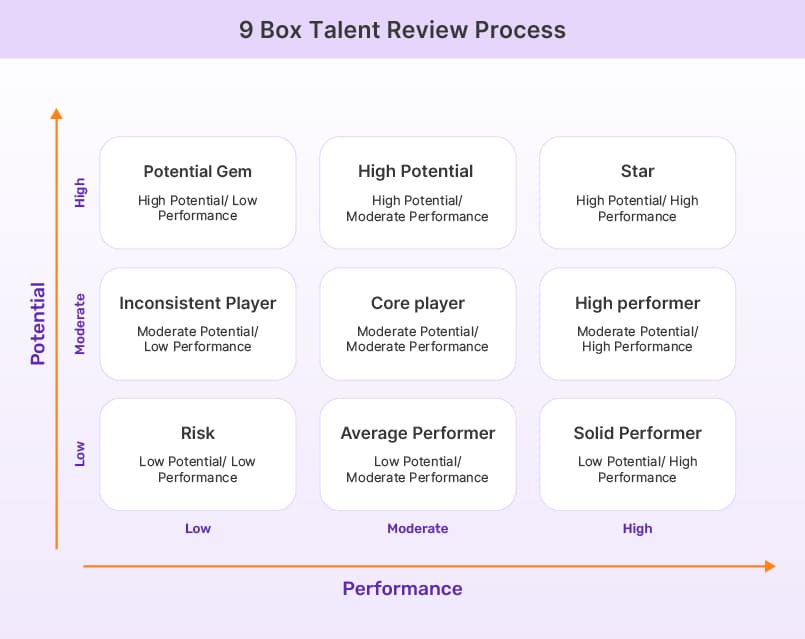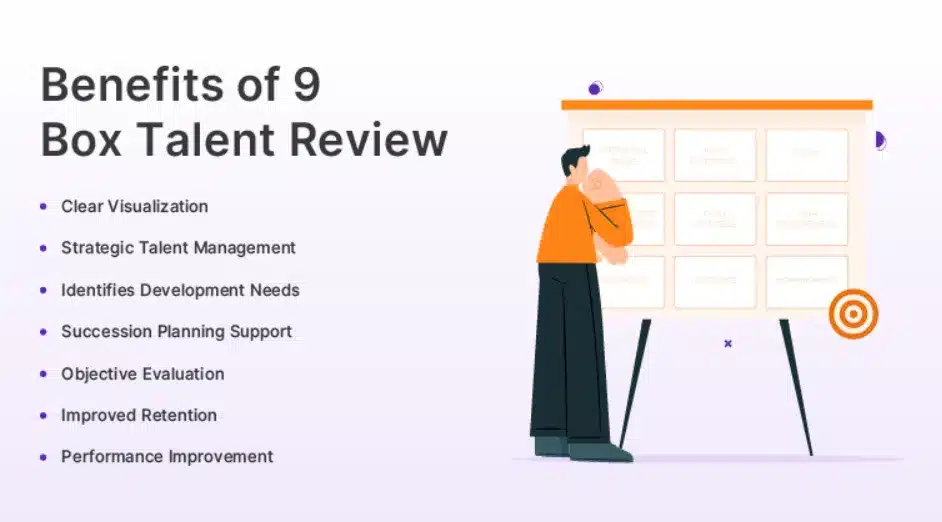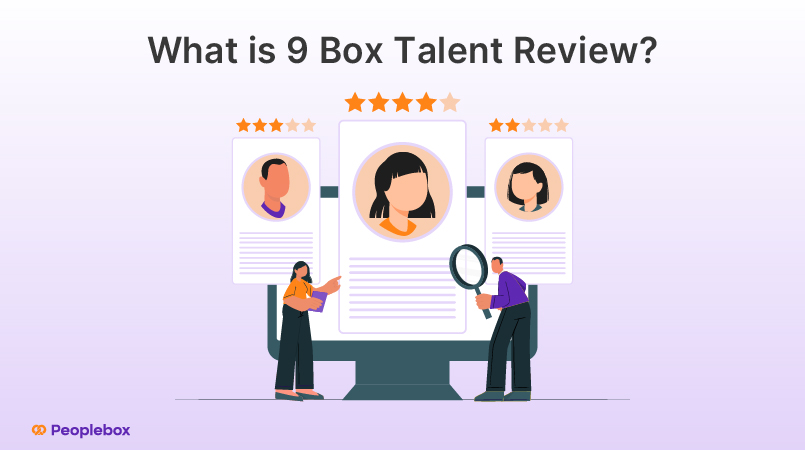The 9 box talent review is a widely used HR tool for assessing employee performance and potential. It provides a structured framework to identify future leaders, inform succession planning, and guide talent development initiatives.
By evaluating employees across two key dimensions—performance and potential—organizations can make more informed decisions about investing in their workforce.
This blog post offers a comprehensive guide on the 9-box talent review, including its benefits, steps for implementation, and considerations for effective use.
Whether you’re new to this talent management technique or looking to refine your approach, this article will equip you with the knowledge to leverage the 9-Box grid for strategic workforce planning.
Key Takeaways
👉 A 9 box talent review is a tool that assesses employees on performance and potential for future growth.
👉 It’s a 3X3 matrix that helps identify talent across different levels in the organization.
👉 Download Our Free 9-Box Grid Template!
What is a 9 Box Talent Review?
The 9 Box Talent Review is a performance assessment tool that enables organizations to evaluate and categorize employees based on their performance and potential. It involves plotting employees on a 9 Box grid, forming a matrix-like framework.

The horizontal axis of the grid represents performance, indicating an employee’s current level of effectiveness in their role. The vertical axis represents potential, reflecting their ability to grow, take on higher responsibilities, and assume leadership positions in the future.
The 9 box talent review matrix aids in identifying high-potential individuals, determining development needs, and making strategic talent management decisions.
🧬 Origins and Evolution of 9 Box Talent Review in Talent Management
The origins of the 9 box talent review can be traced back to its creation by McKinsey in 1970.
Initially used by General Electric (GE) to identify key investments and compare different business units, the 9 Box talent assessment process later evolved into a widely adopted HR tool.
Over time it evolved to accommodate the changing dynamics of the workforce and business environment. While the basic premise remains the same, organizations have adapted the framework to suit their specific needs and align with their unique people management strategies.
The emphasis has shifted from solely focusing on performance ratings to a more holistic assessment that considers future potential, skills, competencies, and future organizational needs.
Also read: How to use 9 box grid?
🔑 Key Components of 9 Box Review
The 9 Box grid consists of two axes that play a crucial role in evaluating employees: performance and potential.
⚙️ 1. Performance
This axis focuses on evaluating an individual’s current and past performance levels. It involves assessing how effectively the employee is fulfilling their responsibilities, achieving goals, and contributing to the organization’s success.
Performance evaluations may consider factors such as quality of work, productivity, teamwork, problem-solving skills, and adherence to company values and standards.
🌱 2. Potential
The potential axis assesses an individual’s potential for growth and advancement within the organization. It looks beyond their current performance and evaluates their ability to take on additional responsibilities, develop new skills, assume leadership roles, and make significant contributions in the future.
Potential assessments consider factors such as learning agility, adaptability, leadership potential, critical thinking abilities, and willingness to embrace new challenges.
How to Use the 9 Box Review Framework?
The 9 box talent review framework can be used in 3 simple steps.
1️⃣ Assess Employee Performance
Begin by evaluating and assessing each employee’s performance. Consider their achievements, contributions, and overall effectiveness in their current role.
This evaluation should be based on objective criteria, such as key performance indicators, targets met, feedback from managers and peers, and performance appraisal data.
With performance management platforms like Peoplebox, assessing employee performance is easy. Try it out yourself!TAKE A TOUR
2️⃣ Assess Employee Potential
Next, assess each employee’s potential for growth and advancement within the organization. Look at their ability to take on additional responsibilities, acquire new skills, and assume leadership roles.
Consider factors such as their willingness to learn, abilities, aspirations, adaptability, problem-solving capabilities, behavior, and leadership qualities.
This assessment should focus on their future growth opportunities and potential for career development.
3️⃣ Merge Performance and Potential into a 3×3 Grid (9 Boxes)
Once you have evaluated both performance and potential, merge the two assessments into a 3×3 grid, also known as the 9-box grid. This grid consists of three columns representing low, medium, and high performance levels and three rows representing low, medium, and high potential levels. Plot each employee’s performance and potential scores in the box that corresponds to their evaluation.
The resulting 9 Box grid categorizes employees into different segments, such as high potentials, high performers, individuals needing development, and those requiring immediate attention.
Peoplebox gives you a holistic view of all your employees and the grids they fall into. With a few clicks, you can understand the distribution of talent across the organization.
What Do the 9 Boxes Represent in the 9 Box Talent Matrix?
The 9 boxes or cells of the 9 Box grid of the 9 box performance review represent different combinations of potential and performance levels. Let’s learn what they represent:

1. High Potential, High Performance: Employees with exceptional performance and demonstrated potential for growth and advancement within the organization.
2. High Potential, Moderate Performance: Employees who show promise and potential but may need further development or support to reach higher performance levels.
3. High Performance, Moderate Potential: Employees who consistently perform well in their current role but may have limited potential for growth beyond their current position.
4. Low Potential, High Performance: Employees who excel in their current role but may have limited potential for growth or advancement within the organization.
5. Moderate Potential, Moderate Performance: Employees with average performance and potential, who may benefit from targeted development initiatives to enhance their skills and contributions.
6. High Potential, Low Performance: Employees with significant potential but whose current performance does not meet expectations. They may require focused development plans to bridge the performance gap.
7. Moderate Performance, Low Potential: Employees who demonstrate average performance but have limited potential for growth or advancement within the organization.
8. Low Potential, Moderate Performance: Employees with moderate performance levels but limited potential for significant growth or advancement.
9. Low Potential, Low Performance: Employees with below-average performance and limited potential for growth within the organization, require careful evaluation and support to improve their contributions.
The Advantages of 9 Box Talent Review in Performance Reviews
The 9-Box Talent Review offers several advantages in conducting effective performance reviews, enhancing how organizations evaluate and develop their employees. Here are the key benefits:

1. Clear Visualization: Provides a straightforward visual tool to map employees based on performance and growth potential, making it easier to identify and categorize talent.
2. Strategic Talent Management: Enables informed decisions on promotions, development plans, and succession planning by categorizing employees into nine distinct boxes based on their performance and potential.
3. Identifies Development Needs: Highlights areas where employees need improvement, facilitating targeted development initiatives and training programs to address specific skill gaps.
Did you know there is a simple tool, a.k.a the skills matrix, that helps you identify skills gaps effectively? Read all about it in our blog post!
4. Succession Planning Support: Identifies high-potential employees and future leaders, ensuring a robust talent pipeline for key positions and reducing the risk of leadership gaps.
5. Objective Evaluation: Promotes a balanced and objective assessment by considering both performance and potential, reducing biases in performance reviews.
6. Improved Retention: Recognizes and develops high-potential employees, leading to higher retention rates and lower turnover.
7. Performance Improvement: Helps underperformers understand their weaknesses and provides a clear path for improvement, contributing to overall organizational success.
Performance Review Platform
Get a glimpse of how Peoplebox make performance reviews painless, actionable and fair
Master the 9-Box Talent Review for Smarter Succession Planning
🤔 How to Use 9 Box Talent Review for Performance Management?
We already mentioned how you can use 9 box grids in general. But what are the exact steps you should follow while using it for performance management? We’ll tell you!
1. Define Clear Objectives
Before implementing the 9 box talent review, it is essential to establish clear objectives. Determine what specific outcomes or goals you aim to achieve through the talent review process.
This could include identifying high-potential individuals, assessing performance and potential alignment, or guiding talent development and succession planning initiatives.
2. Gather Relevant Data
To conduct an accurate talent review, gather relevant data that provides a comprehensive view of the employee’s performance and potential.
This may involve collecting performance reviews, competency evaluations, and potential assessments. Performance management platforms like Peoplebox come in handy here.
Relying on reliable and objective data sources is crucial to ensuring the integrity and validity of the assessment process.
3. Determine Metrics for Comparison
Define the performance metrics that differentiate low performers from high performers and those with low versus high potential.
Establish clear criteria for assessing performance and potential, such as key performance indicators, behavioral competencies, career aspirations, and growth capabilities.
This ensures consistency and fairness in evaluating employees across teams and departments.
4. Objectively Place Employees on the Grid
The process of placing employees on the 9 Box grid should be objective and calibrated across different teams and departments. Reviewers should compare and align their assessments to minimize biases and discrepancies.
Obtaining consensus among reviewers through discussion and collaboration helps ensure fairness and accuracy in the placement of employees on the grid.
Next, let’s examine how you can identify action items and improve the performance of employees in your organization.
How to Identify Action Items and Improve Performance?
The 9 Box Talent Review plays a vital role in identifying specific action items to improve employee performance. Here are key steps to accomplish this:
💬 Continuous Feedback and Evaluations
Regularly provide employees with constructive feedback and evaluations based on their performance and potential assessments. This ongoing feedback helps individuals understand their strengths and areas for improvement and aligns expectations for development.
📈 Monitor Progress and Adjust as Needed
Continuously monitor employee progress and performance to ensure they are on track. Regular check-ins and performance reviews allow for course correction and adjustments as necessary. This helps keep individuals accountable and ensures they are working towards achieving their goals.
🗒️ Create Individualized Development Plans
Based on the 9-box talent review outcomes, create individualized development plans for each employee. These plans should address specific areas of improvement and focus on enhancing the skills, knowledge, and capabilities required for growth and advancement. Tailor development activities to meet each individual’s unique needs.
👨💼Provide Training and Development Opportunities
Offer relevant training programs, workshops, mentoring, and coaching opportunities to support employees’ development plans. This helps them acquire new skills, improve performance, and prepare for future roles and responsibilities.
➕ Foster a Culture of Continuous Improvement
Cultivate a culture of continuous improvement by encouraging employees to seek out opportunities for growth and learning. Promote a mindset of self-reflection, innovation, and professional development throughout the organization.
🏆 Recognize and Celebrate Achievements
Acknowledge and celebrate the achievements and milestones of employees who show improvement and perform exceptionally. Recognition boosts morale, motivates individuals to excel, and fosters a positive work environment.
Suggested Read: Succession Planning Strategies for HR
FREE 9 Box Talent Review Template
Not sure where to begin your 9 box talent review journey? We’ve got you covered! Download our easy, customizable 9-box grid template and get started today.
Performance Management Made Easy with Peoplebox
Peoplebox is a comprehensive platform that enhances the 9-box grid implementation and simplifies performance management.
It streamlines feedback, goal setting, and performance reviews, fostering a culture of continuous feedback, data-driven assessments, and goal-oriented performance management.
Peoplebox empowers managers and HR professionals to conduct regular check-ins, provide real-time feedback, and facilitate meaningful performance conversations, promoting employee growth and development.
Need help with performance management? Get in touch with us today!
Performance Review Platform
Get a glimpse of how Peoplebox make performance reviews painless, actionable and fair








